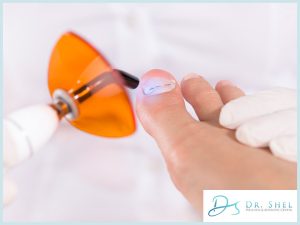Nobody Wants To Have The “F” Word On Their Toenails, But It’s Fortunately Treatable, Especially When You Catch It Early And Receive Laser Toenail Fungus Removal.
 Oh my! Look at my toenail!
Oh my! Look at my toenail!
Did you find yourself saying this recently? Perhaps it was even accompanied by telling your partner something along the lines of “Have you ever seen anything like this?”
While a formal diagnosis from Dr. Shel can let you know the cause, we have a few red flags to look for so you know when to schedule a doctor’s appointment and if laser toenail fungus removal may be needed soon. This treatment will help you to be sandal-ready just like that.
Reduce toenail discoloration and correct cracking so you have feet you won’t want to hide behind a pair of socks.
Signs You Have a Fungus
These are signs your toenail has a fungus.
-
Has Discoloration
Discoloration is the most prominent sign you have fungus because it’s a highly visible indication. Sometimes, only part of your toenail may appear white, yellow, or brown, but the entire nail could be affected. Black spots could develop as well.
The color change happens whenever the fungus breaks down the tissue. Not to mention, the fungal waste product — particularly whenever the infection has spread — may stain the nail.
Keep in mind that discoloration doesn’t always mean fungus. Some other possible causes include the following:
- Injury
- Aging
- Nutrient deficiencies (particularly iron, zinc, or B12)
- Toenail polish staining
- Diabetes, thyroid disease, or psoriasis
- Bacterial infections (not as common as fungal ones)
-
Is Thickening
Even if your nail looks normal colored, if you notice it thickening, you might have fungus. This can aesthetically affect the appearance of your toenails when you have an abnormally larger one. What really might make this problematic, however, is when you go to cut your toenails.
Interestingly, that extra toenail growth is often your body’s way of trying to protect the toenail. Whenever the infection damages enough of your nail, your nail matrix (the portion directly underneath the cuticle responsible for producing the new nail cells) produces extra keratin — the primary protein in this tissue.
And this can be a vicious cycle, as all that extra nail traps moisture, creating the ideal environment for microbes to thrive. The nail then thickens even further, and so forth.
These microorganisms aren’t the only reason for nail thickness. In fact, these may be caused by:
- Aging
- Nutrient deficiencies (zinc, biotin, or protein)
- Thyroid disorders
- Psoriasis
- Chronic obstructive pulmonary disease (COPD) or other lung diseases, in rare cases
- Bacterial infections
- Poor circulation
-
Has Changed Shape or Texture
Compared to the other symptoms on this list, this one may not be as noticeable, so examine the nail closely.
Specifically, you may notice the affected nail looks warped, uneven, pitted, or indented. Rather than having a smooth texture like a healthy nail, an infected one may feel hard or rough.
So, you know, these changes may happen from either the inflammation or the fungus attacking the nail matrix.
Like the other symptoms, these changes could have alternative causes, such as psoriasis, aging, dermatitis, trauma, a thyroid disorder, or nutrient deficiencies (zinc or protein).
-
Has Become Brittle, Ragged, or Crumbly
This goes along the lines of changes in shape and texture, but these are specific signs to watch out for when examining your toenails: brittle, crumbly, ragged, or otherwise weakened nails.
All these changes come from the fungus damaging the nail’s growth and integrity. For one, the enzymes released from the fungus will damage the nails. That’s not the only reason, though.
Others include:
- Moisture retention
- Thickening may cause the nail to crack when being trimmed
- Inflammation
You could suffer from this problem for other reasons as well, like:
- Psoriasis
- Vitamin deficiencies (biotin, iron, vitamin A or E, or zinc)
- Aging
- Bacterial infection
- Circulation issues
- Some medications
-
Is Separating From Nail Bed
A concerning visible sign, especially because it’s one of the more severe ones, is a toenail separating from the nail bed. This is a tell-tale sign of a serious disease or damage to the nail.
Fungus is a major cause because it does the following:
- Damages the nail bed and nail attachment
- Causes inflammation that interferes with the connection
- Damages or irritates the nail bed from its waste products
- Damages the tissue from the infection
- Causes issues from the increased keratin production
Let us point out that any severe damage or disease can lead to toenail loss.
-
Has a Smell
Changes in appearance are the main signs to look out for, but take notice if you smell something not right coming from your toes.
While going hard at the gym can cause your feet to exude some not-so-pleasant odors, the smell won’t directly affect your nails, but a fungus will.
Now, you’re probably questioning, “What scent does toenail fungus have?”
To answer, while the smell can be sweet or fruity from some bacteria and fungus, it’s more common for it to smell musty or earthy. Sometimes, from certain infections, it’s more of a cheese-like scent.
And possibly the worst smell of them all is a sour or rotten scent, which comes from the nail decaying as the infection worsens.
Bad smells aren’t exclusive to nail fungus, though. Other possible reasons include:
- Bacterial nail infections
- Diabetes
- Peripheral artery disease (PAD)
- Systemic infections
So, How Did You Get That Infection?
You might be fairly certain you have a fungal infection, but that doesn’t exactly explain how you got it.
-
How Fungi Enter the Skin
Usually, fungal toenail infections stem from dermatophyte fungi — non-photosynthetic microscopic organisms, meaning they don’t need sunlight to survive. In fact, they thrive best in moist areas, such as showers or pools.
When you come in contact with them there or where someone else spread them, they’ll weasel their way into even the tiniest cuts in the skin, including a separation between your nail bed and nail.
-
Most Common Causes
Some more obvious reasons are walking barefoot in a locker room or getting a pedicure at a nail salon from somebody who didn’t sterilize your tools properly. But, something you didn’t think of could also be the culprit, such as:
- Wearing sweaty socks
- Sharing personal care items like nail clippers
- Coming in contact with somebody’s skin who’s infected
- Drying your feet inadequately after a shower
If you’ve recently been on antibiotics, your risk is a bit higher because they wipe out your unhealthy bacteria along with your healthy ones, particularly those in your digestive tract. Unfortunately, good bacteria keep yeast at bay, so whenever it’s low, yeast can thrive.
As a side note, fungus isn’t limited to your toenails. Though we don’t treat them, you can have a fungal infection in other parts of your body that’ll cause any of the following:
- Bloating, acid reflux, gas, or diarrhea
- Thrust
- Vaginal yeast infection
- Athlete’s feet
We can, however, treat fingernail fungus with a Laser Toenail Fungus Removal. Most often, it manifests as a yellow or white spot under the tip of the fingernail. We should note this isn’t as common as toenail fungus.
-
Risk Factors
Interestingly enough, fungi don’t discriminate. Both men and women develop it, and people of all ages and from all walks of life can contract it. That said, men tend to get it more often. And your chances are also higher because of any of the following:
- Are getting older
- Have athlete’s foot
- Perspire heavily
- Have circulatory problems
- Work in a humid environment
- Have a weakened immune system
Learn more here: What is Laser Hair Removal in Sugar Land, TX, and is it Right for Me?
Reach Out to Discover if Laser Toenail Fungus Removal Is Right for You
 If you’re having one or more of the symptoms mentioned, reach out to Dr. Shel Wellness & Aesthetic Center today for treatment!
If you’re having one or more of the symptoms mentioned, reach out to Dr. Shel Wellness & Aesthetic Center today for treatment!
Those symptoms can easily cause you to hide your toes in shoes, no matter the weather. But, what’s even worse — severe cases may lead to complete toenail loss.
With laser toenail fungus removal, however, you may restore the health of your nail without needing surgical toenail removal. And the treatment even stimulates healing — a major win in the battle against fungus!
If that isn’t enough, there’s no downtime, and some people may see full results in as little as one appointment, though most need two to three.
For those who have toenail problems from nutrient deficiency, we also offer an array of IV Therapy to stop the issues.
On a side note, as you’re deciding on a physician, here are some reasons to choose Dr. Shel. Read our reviews click here.
Wave goodbye to toenail fungus for good with laser treatment! Contact us today at (281) 313-7435 to book a consultation.


















